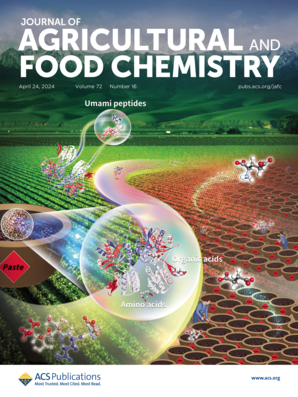地中海启发的(多)富酚混合物在脑中的代谢谱:灌注效应和体外血脑屏障运输验证
IF 5.7
1区 农林科学
Q1 AGRICULTURE, MULTIDISCIPLINARY
引用次数: 0
摘要
富含(多)酚的地中海饮食与神经保护有关,但其效果可能取决于酚代谢物穿过血脑屏障(BBB)的能力。本研究评估了Sprague-Dawley大鼠在口服地中海食物(石榴、柠檬、橙子、葡萄和橄榄)中富含多酚的提取物混合物后,其血浆和脑内酚代谢物的动力学分布。UPLC-ESI-QTOF分析显示血浆中有39种酚衍生代谢物,其中20种存在于未灌注脑(NPB), 19种存在于灌注脑(PB),包括羟基酪醇和酪醇硫酸盐、鞣花酸、二氢咖啡酸及其衍生代谢物。动力学数据显示血浆代谢物浓度明显高于大脑,NPB水平略高。在体外使用人脑微血管内皮细胞(HBMECs)验证了酚类代谢物的血脑屏障运输效率,当作为混合物测试时显示出改善的运输。这些发现证实,来自地中海食物的循环酚类代谢物可以到达脑组织,有助于预防神经退行性疾病。本文章由计算机程序翻译,如有差异,请以英文原文为准。

Metabolic Profiling of a Mediterranean-Inspired (Poly)phenol-Rich Mixture in the Brain: Perfusion Effect and In Vitro Blood–Brain Barrier Transport Validation
A Mediterranean diet rich in (poly)phenols has been linked to neuroprotection, but its effects likely depend on the ability of phenolic metabolites to cross the blood–brain barrier (BBB). This study evaluated the kinetics plasma and brain distribution of phenolic metabolites in Sprague–Dawley rats following oral administration of a polyphenol-rich extract mixture from Mediterranean foods (pomegranate, lemon, orange, grape, and olive). UPLC-ESI-QTOF analyses revealed 39 phenolic-derived metabolites in plasma, of which 20 were in nonperfused (NPB) and 19 in perfused brains (PB), including hydroxytyrosol and tyrosol sulfates, ellagic acid, dihydrocaffeic acid, and derived metabolites. Kinetic data showed substantially higher plasma metabolite concentrations than the brain, with slightly higher levels in NPB. The BBB transport efficiency of phenolic metabolites was validated in vitro using human brain microvascular endothelial cells (HBMECs), showing improved transport when tested as mixtures. These findings confirm that circulating phenolic metabolites from Mediterranean foods can reach brain tissues, contributing to preventing neurodegenerative diseases.
求助全文
通过发布文献求助,成功后即可免费获取论文全文。
去求助
来源期刊
CiteScore
9.90
自引率
8.20%
发文量
1375
审稿时长
2.3 months
期刊介绍:
The Journal of Agricultural and Food Chemistry publishes high-quality, cutting edge original research representing complete studies and research advances dealing with the chemistry and biochemistry of agriculture and food. The Journal also encourages papers with chemistry and/or biochemistry as a major component combined with biological/sensory/nutritional/toxicological evaluation related to agriculture and/or food.

 求助内容:
求助内容: 应助结果提醒方式:
应助结果提醒方式:


